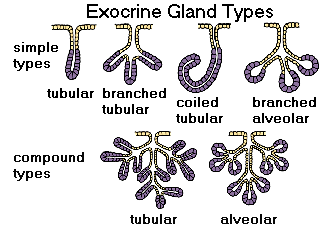exocrine glands

Exocrine glands are glands that discharge secretions by means of a duct, which opens onto an epithelial surface (a tissue that covers the external surface of the body and lines hollow structures inside the body). Exocrine glands include the sweat, sebaceous, and mammary glands, and the glands that secrete digestive enzymes. Most glands in the body are exocrine types. The other major category of glands in the body consists of the endocrine glands.
Types of exocrine glands
Unicellular exocrine glands
These consist of single cells, specialized for secretion, which are interspersed amongst other, non-secretory epithelial cells. Although, being unicellular, they lack ducts, they are nevertheless considered to be exocrine because they secrete their products directly on the free surface of open body cavities. The most common unicellular exocrine glands are the goblet cells (mucus secreting cells) found in the epithelium of the trachea and the digestive tube.
Multicellular exocrine glands
These are formed by invagination, or in-pouching, of an epithelial sheet. The epithelium grows down from the surface into the underlying tissues to form either a simple or compound tube. The blind end of the tube constitutes the secretory parts of the gland and may stay tubular or expand to form round bags called acini or alveoli. The various structural types of exocrine glands are shown in the illustration.
There are three different ways in which exocrine glands secrete their products. These modes of secretion are called merocrine, apocrine, and holocrine.


